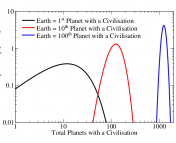Title: Dynamical considerations for life in multihabitable planetary systems
Authors: Jason H. Steffen and Gongjie Li
First Author’s Institution: University of Nevada, Las Vegas, Department of Physics and Astronomy
Status: Accepted to ApJ
We would all like to have good relations with our neighbors, but just how friendly are planetary neighbors? Could they make your life a disaster, or could they be your best friends? The authors of this paper explore two aspects of this neighborly relationship: 1) can a planet’s neighbor cause it to tip over more easily, which would cause violent climate change, and 2) can it seed its neighbor with life?
Changing the tilt:
The Earth’s axial tilt, or obliquity, remains relatively stable at about 22.1-24.5° (now 23.5°), but without the Moon, it might vary anywhere between 0-45°. This could result in extremely violent climate change and extreme seasonal variations. Mars may just have such a chaotic obliquity history, although it’s debatable how much these extreme changes in climate could affect a planet’s habitability. Just like the Moon’s presence can stabilize Earth’s obliquity, orbital interactions with a nearby planet might be able to destabilize it, particularly if they are in orbital resonance. Planets are in resonance when their orbital periods are related by a ratio of small integers, such as 2:3 (e.g., a planet with a period of 20 days and another with a period of 30 days). In fact, the 6:7 resonance of Kepler-36 b and c inspired this paper.
The authors simulate planetary systems at several different orbital configurations to test whether orbital resonance destabilizes a planet’s obliquity. Afterwards, they compared these simulations to a control set of non-resonant planets with similar orbital properties. Separately, they investigated a solar system analog where they replace the Earth with a pair of moonless, Earth-mass planets in a 6:7 resonance centered around 1 AU. In these scenarios, they found that the presence of nearby planets did not significantly increase the obliquity variations over the length of their 20 Myr simulation regardless of whether the planets were in resonance. In fact, the 6:7 pair of Earths exhibited less obliquity variation than a a single, moonless Earth when the starting obliquity was <20° (see Figure 1).

The obliquity variation of three planets as a function of initial obliquity. The three colors of symbols represent the minimum, median, and maximum obliquity over a 20 Myr simulation. Top: a moonless Earth. Middle: The inner planet of a pair of moonless Earths in a 6:7 resonance centered at 1 AU. Bottom: The outer component of the pair of 6:7 moonless Earths.
Panspermia:
If two habitable planets are so close to each other though, one might also wonder if life could jump from one to the other. Life on one planet could hitch a ride to the next if an asteroid or comet collision knocked material off the planet (ejecta) which then found its way to another. The idea that life on Earth got its start on Mars is a popular one in the media. However, if there were two Earth-like planets in a 6:7 resonance, the relative angular size of each planet would be 25 times larger than Earth would look from Mars, providing a much larger target for an accidental, space-faring microbe.
The authors took the same planetary simulations as before and added in ejecta from hypothetical asteroid collisions. Each planet was divided in 768 regions, each being the source of three ejecta particles, each of which given a random velocity. This was done at 10 different times to randomize where the planets were in their orbits. The planetary system was then evolved for 10 million years to see how much of the ejected material of one planet ended up on the neighboring planet.
They found three important conclusions:
- Less energetic collisions were able to transfer material from one planet to the next because the relative difference in orbital velocities between the planets were small.
- Lower required velocities mean more of the planet’s surface can source material to its neighbor.
- If one particle is transferred from one planet to the next, the probability that other particles will also transfer successfully shortly afterwards increases. The particles’ probability are not independent of one another.
As expected, the overall rates of material transfer from one planet to the next greatly increases as the planets get closer and closer. These conclusions on panspermia and obliquity bode well for the probability of life forming on pairs of planets orbiting close together. Furthermore, if life were found on one, there could be a high probability that life found its way to the other, stretching the tree of life throughout the system.





Seems the stabilizing effects of resonances can like the phylogenetic tree stretch wider, if there are other planets (and especially a gas giant) in the system and the planet is rotating fast or retrograde. [ http://www.astrobio.net/news-exclusive/earths-moon-may-not-critical-life/ ]
Another stretching effect mentioned in that small review is that having a tilt is putatively stretching the surface HZ a bit outwards. As almost always, it is complicated.